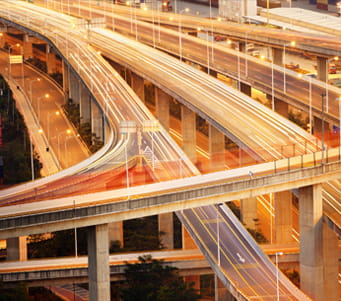“If you build it, they will come”. These were the illustrious words on the wind that inspired an Iowa farmer in the 1989 blockbuster, Field of Dreams, to level corn and plant a baseball diamond for resurrected legends in its stead. But the words that brought a Chicago White Sox team back from the dead are not only good for a night of ‘Totally 80s: Trivial Pursuit’. They’re just as handy in the boardrooms of world economic development.
If you build a road, they will also come.
That’s essentially the big idea that built the Silk Road and shaped the geopolitical terrain of central Asia. It’s the motive behind turnpike construction in 19th-century industrial America. And it’s still one of the greatest catalysts for growth within the developing world today.
As our technologies continue to evolve and re-craft our infrastructure solutions, the strategies to stimulate economies and untap new markets can easily appear daunting and dizzying in complexity.
But history – and basic economic theory ‒ could argue that the same steady logic which built the industrialised world still applies today. Build a corridor, and you by default help build a nation.
Stuck in the mud
There is a kingpin theory of economics that says movement is money. The broader your market, the greater your chance to expand your business and pump more money back into the local economy. More access, more connectivity; and more connectivity, more influence and profitability.
Geographical isolation, on the other hand, hinders economic growth and roadblocks innovative momentum.
According to a UN–Habitat study on poverty and sustainable transport, the majority of rural Africa does not live within five kilometres of an all–weather road. In Latin America, roads may be slightly more prolific but their unpaved and unkempt conditions (representing 78 per cent of the region’s total road network) often render them unusable. The result is a type of economic paralysis that forces local markets to stay small, expensive and vulnerable to regional conditions.
Changing mindsets around the poor
 Management scholar CK Prahalad argues that the degree to which we can unlock the market potential of these remote and under-invested communities will determine our future economic prosperity. He says our most potent entrepreneurial talent and consumer opportunities is found among the two-thirds of the world’s population living at or near the poverty line.
Management scholar CK Prahalad argues that the degree to which we can unlock the market potential of these remote and under-invested communities will determine our future economic prosperity. He says our most potent entrepreneurial talent and consumer opportunities is found among the two-thirds of the world’s population living at or near the poverty line.
These four billion people living ‘at the bottom of the [financial] pyramid’ are brimming with tremendous opportunity, skills, and knowledge that in fact make them the engine for the next round of global trade and prosperity.
Our most potent entrepreneurial talent and consumer opportunities is found among the two-thirds of the world’s population living at or near the poverty line. “If we stop thinking of the poor as victims or as a burden and start recognising them as resilient and creative entrepreneurs as well as value conscious consumers, a whole new world of opportunity will open up,” says Prahalad.
This type of action requires a massive shift in mindset, in which the developed world no longer sees its role as donors or mentors, but as potential colleagues and consumers on equal footing. The assumption here is that ‘everybody, not just the elite’ will take part in the story of globalisation and reap its rewards. For this to happen, a change in posture is needed, one that offers a handshake over a handout.
The concept of fighting poverty with profitability is intriguing; it overrides the classic language of international development that teems with top down terminology around teaching communities ‘how to fish’. Essentially Prahalad is saying, “they’ve been fishing all along. We need to connect them to bigger ports.”
The visible and invisible roads
So, when it comes to uncorking and connecting this latent potential of disconnected communities within the developing world, a good road network is a good place to begin. Suddenly, agricultural communities have new markets for buying and trading; the ease of travel ups production and lowers freight costs; human connectedness increases local employment; and profitability boosts standards of living.
Shop owners can reduce prices, thanks to lower import costs, and ease the burden on local consumers. There’s now new space for entrepreneurial innovation to run. And there’s impetus for consumers to start buying better quality cars.
Or, roadways could take on less visceral forms, linking isolated communities to markets that rely primarily on the digital movement of data. Countries only starting with industrialisation may be more poised to leapfrog expensive and traditional infrastructure and go straight into more efficient, digital forms. Information highways can potentially unlock profound market value, even if the asphalt is never laid. After all, corridors of the future are becoming all the more invisible as the future unfolds.
Roads facilitate growth and health, knowledge and equality – all cornerstone elements of civil society on which humanity aims to build. You’ll let out the first ripple of many.
This blog was authored by: Portia Derby





